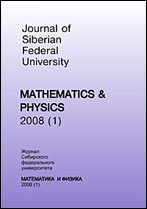|
|
Journal of Siberian Federal University. Mathematics & Physics, 2011, Volume 4, Issue 2, Pages 208–216
(Mi jsfu179)
|
 |
|
 |
Dynamic features of frontal zones structure in the ocean for using in the numerical models based on satellite data
Alexey V. Kartushinskyab
a Siberian Federal University, Krasnoyarsk, Russia
b Institute of Biophysics, SB RAS, Krasnoyarsk, Russia
Abstract:
Structural changes in the oceanic temperature frontal zones instead of TFZ, which are determined by the MSST satellite data, are related to the character of interactions between currents. Different intensities of interactions between currents cause either an increase or a decrease in SST gradients. In this work we discuss the reasons causing sharpening of SST gradients exhibited in spatial position of TFZs. Advection, turbulent diffusion, and solar radiation are the main factors for TFZs. The study areas for investigating TFZ dynamics are the North and the South Atlantic and the North and the South Pacific. Similarities in the structures of TFZs in different areas of the ocean have been determined. The 2D model is used to study the separate and concerted influence of advection, turbulence, and solar radiation on the formation of frontal zones. We present analytical and numerical estimates of changes in temperature gradients for the major frontal zones in the ocean and compare them with the satellite data. The variability of SST gradients has been quantified based on satellite, model, and analytical data. The obtained data on spatial and temporal scales of TFZs are indicative of the intensities of convergence and divergence of fluxes; these data are necessary for estimating vertical movement of the water mass as a component of the 3D models.
Keywords:
modeling, sea surface temperature gradients, temperature frontal zones, advection, turbulent diffusion, solar radiation, convergence structures.
Received: 10.11.2010
Received in revised form: 10.11.2010
Accepted: 20.12.2010
Citation:
Alexey V. Kartushinsky, “Dynamic features of frontal zones structure in the ocean for using in the numerical models based on satellite data”, J. Sib. Fed. Univ. Math. Phys., 4:2 (2011), 208–216
Linking options:
https://www.mathnet.ru/eng/jsfu179 https://www.mathnet.ru/eng/jsfu/v4/i2/p208
|

| Statistics & downloads: |
| Abstract page: | 245 | | Full-text PDF : | 69 | | References: | 30 |
|




 Contact us:
Contact us: Terms of Use
Terms of Use
 Registration to the website
Registration to the website Logotypes
Logotypes








 Citation in format
Citation in format 